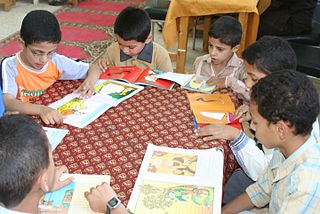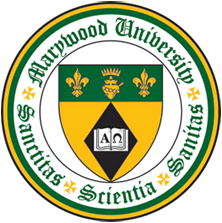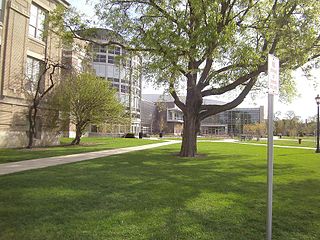An educational institution is a place where people of different ages gain an education, including preschools, childcare, primary-elementary schools, secondary-high schools, and universities. They provide a large variety of learning environments and learning spaces. [1] [2]
Educational architecture, school architecture or school building design is a discipline which practices architect and others for the design of educational institutions, such as schools and universities, as well as other choices in the educational design of learning experiences. The design of building can significantly influence the learning experience of students. [3] Additionally, because schools are important sources of traffic, employment and community activities, school buildings often act as anchor institutions in neighborhoods or communities. [4] [5] The decline of a school can have significant impact on local communities.
Educational buildings are often purpose built: designed with architectural choices unique to schools, such as classrooms and centralized restrooms, and other purpose built features. When the schools are closed, its often hard to repurpose the buildings. For example, in the 2013 Chicago closed 50 school buildings, and even in 2023, the government is having trouble identifying new tenants and use. [6]
Different parts of the world and the different countries have gone through significant changes in philosophies associated with educational institutions, influenced by trends in investment by governments as well as larger changes in educational philosophy.Types of educational institution include:

A school is both the educational institution and building designed to provide learning spaces and learning environments for the teaching of students under the direction of teachers. Most countries have systems of formal education, which is sometimes compulsory. In these systems, students progress through a series of schools that can be built and operated by both government and private organization. The names for these schools vary by country but generally include primary school for young children and secondary school for teenagers who have completed primary education. An institution where higher education is taught is commonly called a university college or university.

The Cranbrook Educational Community is an education, research, and public museum complex in Bloomfield Hills, Michigan. This National Historic Landmark was founded in the early 20th century by newspaper mogul George Gough Booth. It consists of Cranbrook Schools, Cranbrook Academy of Art, Cranbrook Art Museum, Cranbrook Institute of Science, and Cranbrook House and Gardens. The founders also built Christ Church Cranbrook as a focal point in order to serve the educational complex. However, the church is a separate entity under the Episcopal Diocese of Michigan. The sprawling 319-acre (1,290,000 m2) campus began as a 174-acre (700,000 m2) farm, purchased in 1904. The organization takes its name from Cranbrook, England, the birthplace of the founder's father.
This is an index of education articles.
Midrasha is a Hebrew term currently used for three types of educational institutions:

The Church Educational System (CES) of the Church of Jesus Christ of Latter-day Saints consists of several institutions that provide religious and secular education for both Latter-day Saint and non–Latter-day Saint elementary, secondary, and post-secondary students and adult learners. Approximately 700,000 individuals were enrolled in CES programs in 143 countries in 2011. CES courses of study are separate and distinct from religious instruction provided through wards. Clark G. Gilbert, a general authority seventy, has been the CES commissioner since August 1, 2021.

The Mount Vernon School (MV) is a private, independent, coeducational day school in Sandy Springs, Georgia, United States, with an Atlanta postal address. It was founded in 1972. The Mount Vernon School was formerly known as Mount Vernon Presbyterian School (MVPS).

In the 21st century, the Government of Egypt has given greater priority to improving the education system. According to the Human Development Index (HDI), Egypt is ranked 97 in the HDI, and 9 in the lowest 10 HDI countries in the Middle East and Northern Africa, in 2014. With the help of the World Bank and other multilateral organizations Egypt aims to increase access in early childhood to care and education and the inclusion of Information and Communication Technology (ICT) at all levels of education, especially at the tertiary level. The government is responsible for offering free education at all levels. The current overall expenditure on education is about 12.6 percent as of 2007. Investment in education as a percentage of GDP rose to 4.8 in 2005 but then fell to 3.7 in 2007. The Ministry of Education is also tackling a number of issues: trying to move from a highly centralized system to offering more autonomy to individual institutions, thereby increasing accountability. The Human Rights Measurement Initiative finds that Egypt is achieving 89.3% of what should be possible for the right to education, at their level of income.

Marywood University is a private Catholic university in Scranton, Pennsylvania. Established in 1915 by the Sisters, Servants of the Immaculate Heart of Mary, Marywood currently enrolls more than 2,800 students in a variety of undergraduate, graduate, and doctoral programs. The university has a national arboretum with more than 100 types of trees and shrubs.

Don Bosco Technical College, also referred to by its acronym DBTC, Don Bosco Mandaluyong or informally DB Manda, is a private Catholic basic and higher education institution run by the Salesians of the Society of Saint John Bosco in Mandaluyong, Metro Manila, Philippines. Established in 1953 by the Salesians, it is the first Don Bosco Educational Center in Metro Manila. Don Bosco Mandaluyong offers co-educational primary (elementary) and secondary education, co-educational senior high school and college, night school, and vocational training for out-of-school youth.
The following is a timeline of women's colleges in the United States. These are institutions of higher education in the United States whose student population comprises exclusively, or almost exclusively, women. They are often liberal arts colleges. There are approximately 35 active women's colleges in the U.S. as of 2021.
Education in the Philippines is compulsory at the basic education level, composed of kindergarten, elementary school, junior high school, and senior high school. The educational system is managed by three government agencies by level of education: the Department of Education (DepEd) for basic education; the Commission on Higher Education (CHED) for higher education; and the Technical Education and Skills Development Authority (TESDA) for technical and vocational education. Public education is funded by the national government.

Saint Michael's Preparatory School was a private, Roman Catholic, college preparatory boys' boarding school in Silverado, California. It was located in the Roman Catholic Diocese of Orange.

New Dorp High School, commonly referred to as New Dorp or NDHS, is a public school in New Dorp on the East Shore of the New York City borough of Staten Island in the New Dorp neighborhood. The school is administered by the New York City Department of Education. The school is located at 465 New Dorp Lane next to Miller Field, an army airport turned park, which extends to the Lower New York Bay. New Dorp High School is located in Region 7, which encompasses all of Staten Island and portions of southwest Brooklyn.

Gwendolyn Brooks College Preparatory Academy is a public 4–year selective enrollment magnet high school and middle school located in the Roseland neighborhood, near the Pullman District on the far south side of Chicago, Illinois, United States. Opened in 1998, The school is operated by Chicago Public Schools district. A university-preparatory school, Brooks is named for African–American poet, author and Chicago native Gwendolyn Brooks.
School organizational models are methods of structuring the curriculum, functions, and facilities for schools, colleges, and universities. The organizing of teaching and learning has been structured since the first educational institutions were established. With greater specialization and expertise in a particular field of knowledge, and a gathering of like-minded individuals, instructors clustered into specialized groups, schools, and eventually departments within larger institutions. This structure spread rapidly during the 19th and 20th centuries with factory model schools and their "assembly-line" method of standardized curriculum and instructional methods. Beginning with the progressive educational movement in the early-mid 20th century, and again with similar trends in the late 20th and early 21st century, alternative models structured towards deeper learning, higher retention, and 21st century skills developed. The organizational models of schools fall into several main categories, including: departmental, integrative, project-based, academy, small learning communities, and school-within-a-school.
Educational architecture, school architecture or school building design is a discipline which practices architect and others for the design of educational institutions, such as schools and universities, as well as other choices in the educational design of learning experiences. The design of building can significantly influence the learning experience of students. Additionally, because schools are important sources of traffic, employment and community activities, school buildings often act as anchor institutions in neighborhoods or communities. The decline of a school can have significant impact on local communities.
The East Florida Seminary was an institution of higher learning established by the State of Florida in 1853, and absorbed into the newly established University of Florida in 1905. The school operated in Ocala from 1853 until 1861. After being closed during the Civil War, the school re-opened in Gainesville, Florida in 1866.